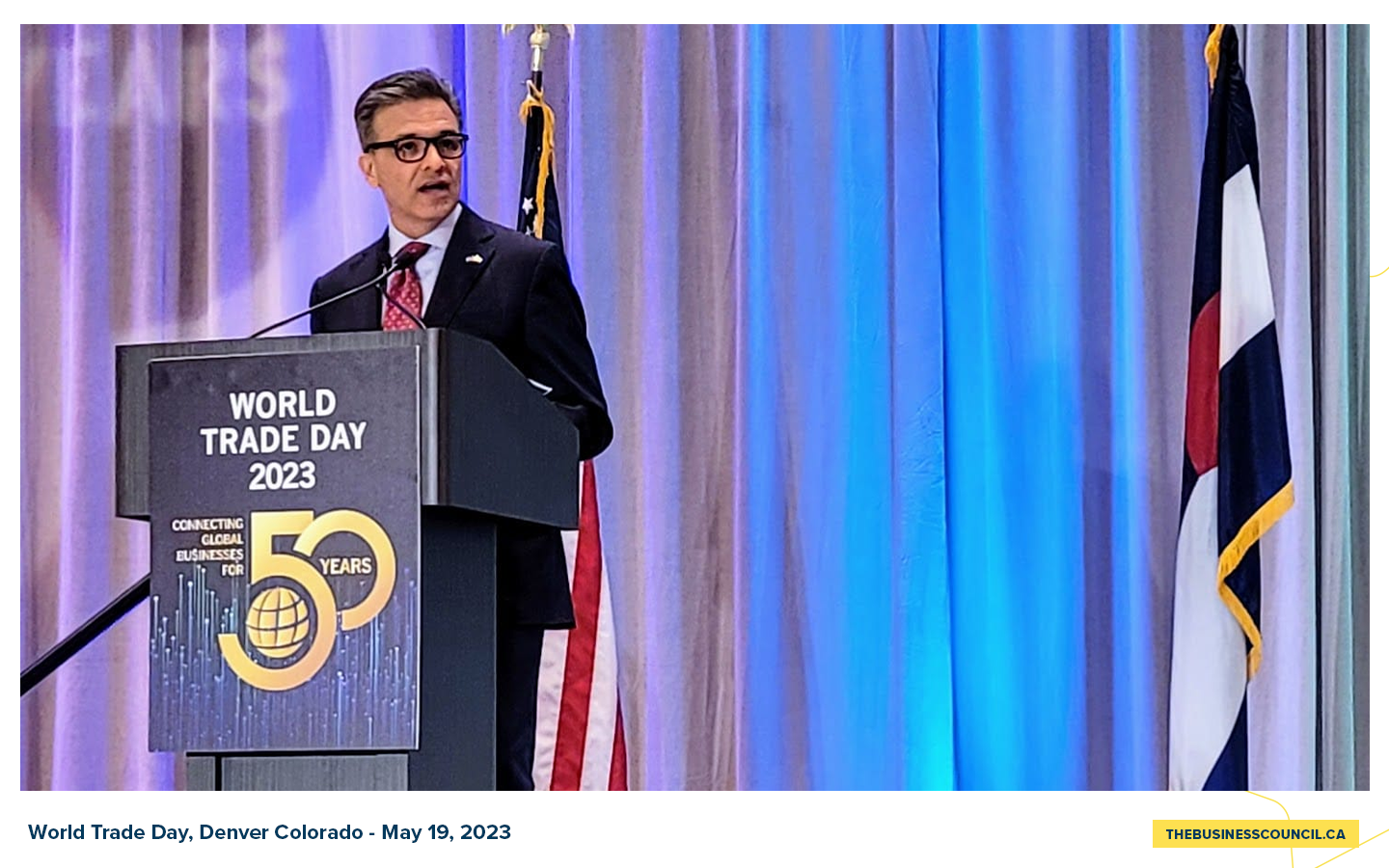The United States and Canada – stronger together
Goldy Hyder keynote speech at World Trade Day Denver 2023 Friday May 19.
It’s an honour to be here and to kick off World Trade Day 2023.
And what a time to be in Denver with the NBA Western Conference finals in full swing! It’s hard not to get caught up in the excitement of the Denver Nuggets and their amazing season.
But as a Canadian I have to admit I’m also watching the hockey playoffs.
On that score I want to offer my condolences.
I know it’s just been a few weeks since the Colorado Avalanche fell in the first round of the Stanley Cup playoffs. My daughters had Colorado in their hockey pool and they feel your pain.
As an Ottawa Senators fan, I can relate to the disappointment. My team didn’t even make the playoffs.
So I consoled myself by watching the Boston Bruins … and their disappointing loss to the Florida Panthers.
As the CEO of the Business Council of Canada, I couldn’t help but feel a special connection to the Bruins.
Not because of their style of play, but because of the logo on their helmets.
TD – one of the members of the Business Council of Canada – was everywhere in those games.
From the branding on the players’ equipment to the arena the Bruins play in – a clear sign that Canada’s banks, among others, are household names here in the United States.
TD isn’t alone, of course. Canadian companies have a long history in the United States. Canadian investment is all around you, embedded into brand names you all know:
- CIBC,
- TC Energy,
- Magna,
- Brookfield.
These are all Canadian.
Our integration in terms of investment, trade and people is profound, mutually beneficial, and precious.
That’s not to say we don’t sometimes compete. There was an interesting little Canada-U.S. competition that sprouted up a couple of weeks ago.
Suzanne Clark is the head of the U.S. Chamber of Commerce as you know, and a good friend to the Business Council of Canada.
She was in Ottawa for meetings with the Prime Minister and other elected officials. She came armed with facts and figures.
At a breakfast meeting with business leaders, she said that when it comes to the speed of approving energy projects … those projects we need to protect our energy security and the environment … Canada was looking better than the United States when it comes to lag time.
Our experience tells a different story. As the saying goes, the grass is always greener on the other side.
It routinely takes more than a decade to make any headway on key projects on both sides of the border, and that’s not something that helps either Canada or the United States.
Earlier this week I met with senator Joe Manchin. As you may know, he is proposing legislation – supported by President Biden – to limit reviews of major energy projects to two years, and just one year for smaller projects.
That would be lightning speed on either side of the border.
I hope he succeeds. One thing we know very well in Canada – you should never short America!
But today the truth is, neither country is moving fast enough.
In the dispute over whether it takes projects longer to get off the ground in your country or mine, my answer is: both countries take too long. That just benefits our competitors elsewhere in the world, especially in autocratic countries where the checks and balances are minimal.
At a time when the International Energy Agency predicts the world will quadruple its demand for critical minerals by 2040, China is dominating world supply and rolling out the red carpet … while we in North America are tying ourselves up in red tape.
At a time when our European and Asian allies are looking for new sources of energy, we in North America are plodding along.
It’s frustrating. We need to think about both our countries in tandem.
We share an AMBITION to cut greenhouse gases and convert to a low-emissions economy.
We share an immense, unprotected BORDER.
We share a WORKFORCE; we share VALUES; and we share a way of DOING BUSINESS.
Our most intense competition is not really with each other, but with the rest of the world.
You will all know that Canada is America’s top trading partner, but I’ll drill down on the facts so that we can all appreciate how profound that relationship is.
In 2022, our two countries exchanged one trillion dollars’ worth of goods and services, making THIS one of the largest trading relationships in the world.
This isn’t a simple trade relationship where we sell each other things for consumption.
We trade back and forth repeatedly, turning raw materials into finished goods, and then building up services around that production to support economies on both sides of the border.
About 80 per cent of Canadian goods exported to the United States are included in American supply chains that serve big and small business alike.
Our own research at the Business Council shows Canadian trade and investment supports more than 2 million American jobs and generates nearly $300-billion dollars’ worth of exports per year.
Right here in Colorado, Canadian businesses support $2.2 billion in exports from your state, and 33 thousand jobs.
Canada is the number-one export destination for 31 separate states, including New York, Georgia, Washington, and yes, Colorado.
And U.S. exports to Canada are worth more than its sales to China, Japan and India combined.
Think about that.
That’s the result of decades and decades of economic integration, set in stone through formal accords such as the Free Trade Agreement of 1989, which expanded to NAFTA in 1993, and renegotiated into the US-Mexico-Canada Agreement in 2020.
The USMCA keeps goods and services flowing almost problem-free across the continent and gives us a way to work out our differences if they arise.
We can’t take the agreement for granted though….and we in Canada certainly don’t.
For sure, there are annoying trade irritants from all three countries.
In fact, that’s what makes the agreement so very vital to our continental economy.
No relationship is perfect, and with the USMCA to guide us, we have a productive and peaceful way to work through our differences.
The agreement allows for billions of dollars’ worth of trade among the three countries every single day.
We can’t let trade irritants stand in the way of our continental cooperation.
The USMCA is the backbone that has served our mutual prosperity so well for so long, and well worth preserving — come what may in public opinion and political upheaval.
The deal was carefully crafted to ensure well-paid jobs stay on the continent, that high standards in labour and environment are met by all employers, and that trade and investment are treated fairly. The kind of prosperity it has brought Americans, Canadians and Mexicans alike is very valuable, especially as the rest of the world reels with uncertainty.
And speaking of politics, another thing our two countries share is a commitment to democracy. It’s remarkable how that kind of commitment is controversial these days.
In Canada and the United States, our leaders used to assume that democracy and capitalism were deeply intertwined and fed off each other in a virtuous circle that led to prosperity, equal opportunity and ambition for the entire world.
This is no longer something we can take for granted.
The COVID-19 pandemic led to a rethinking of who will come through for us with essential goods and services when times are tough.
The Russian invasion of Ukraine led to a rethinking of how some of the world’s largest powers approach sovereignty.
And so when YOUR U.S. Secretary of the Treasury, Janet Yellen, and OUR finance minister and deputy prime minister, Chrystia Freeland, started talking out loud about “friend-shoring,” it signaled a new way of approaching trade and investment around the world – an approach based on common values.
Efficiency is no longer the only consideration in establishing trade, investment and supply chains. It’s just ONE of the considerations.
Resilience is another.
Reliability, and dedication to a rules-based economy, and devotion to democracy are yet others.
Janice Stein, the insightful founding director of the Munk School of Global Affairs at the University of Toronto, calls it the securitization of trade. We secure reliable supplies of the most essential goods. That leads to good solid employment in our own countries. But we MUST resist the political temptation to become protectionist in the process.
Friend-shoring shouldn’t mean Canada-shoring or America-shoring – it should mean North America-shoring.
We’re only beginning to understand what this focus on values means on a global scale.
It’s easy enough when we talk about the bilateral relationship though — about Canada and the United States — because we share so many values and our economies are so deeply integrated.
We ALREADY favour trade and investment with each other.
Yes, we compete like your Colorado Avalanche and my Ottawa Senators, but we’re all in the same league.
In a world where we don’t know what’s lurking behind the motives of key actors beyond our shores, we need to double down on that relationship.
For now, friend-shoring looks different depending on what side of the border you’re on.
In the United States, it means big spending by Washington to build ALMOST everything a country would want right here at home.
“Almost” is the key word. There’s just no way America can do everything by itself, and why would it when it can rely on Canada to provide – at competitive prices – a reliable supply of energy, cars, crops, wood, plastic, aluminum, fertilizer, uranium. Half a trillion dollars’ worth of goods last year alone.
We’re engaging in our own form of friend-shoring too…keeping a close eye on who is investing in our natural resources, and who is building our technology and infrastructure.
But most of Canada’s efforts to grapple with the changes in the global economy are around the energy transition, and, more recently, energy security.
The post-pandemic economy is one that is fraught with cascading crises that are disrupting even the most carefully laid plans of investors and producers – what is now referred to as a poly-crisis
If Canada and the United States are determined to cut emissions, become more self-sufficient in the production of strategic materials such as semi-conductors and critical minerals, and invest heavily in re-orienting our economies towards a low-carbon future, we are much better off doing this in partnership than going it alone.
Canada is really good at innovating around energy. We made our name in oil and gas. And now, we’re forging ahead with carbon capture, utilization and storage, nuclear power, hydrogen, and plans for mass electrification.
In an era of poly-crisis, energy security, economic security and national security are inextricably linked.
We need a concerted effort.
The last Canadian federal budget earmarked 82 billion dollars over the next decade for investment incentives in critical minerals, clean technology and cutting emissions. It’s Canada’s response to the Inflation Reduction Act.
That’s a lot of money for us in Canada, and it didn’t stop there.
In an effort to set the foundation for a robust electric-vehicle supply chain, Ottawa is also giving Volkswagen hundreds of millions of dollars to build a giant battery manufacturing facility in southern Ontario, and then 13 billion dollars in tax incentives to produce the batteries over the coming years.
President Joe Biden doesn’t’ mince his words….I heard it with my own ears when he visited Ottawa in March….he recognizes the central importance of Canada’s critical minerals to producing the materials we all need to cut emissions.
And our own federal ministers have travelled the world highlighting the value of our mineral endowment in the age of global warming.
Prime Minister Trudeau and the innovation minister, Francois-Philippe Champagne, are in Japan this week in fact, highlighting Canada’s capacity.
They make a strong case. We have a history of mining expertise and investment, and now we have an abundance of the very materials that the world, and especially the United States, needs to electrify its fleet.
It makes sense for our two countries to strategize about this together, to have a common approach to how we extract, refine, manufacture, distribute and eventually recycle all the bits and pieces that go into the electric cars that are our future.
But the immediate challenge, for both our countries, is getting those critical minerals out of the ground and into the bi-national supply chain.
We need to hold each other to account, to make sure the infrastructure that’s required to extract, process and ship those materials spans the border and works flawlessly.
As I mentioned at the beginning, approvals for mining projects drag on and on, both in Canada and the United States. The Canadian government has acknowledged this, and says it wants to speed up the process.
OF COURSE no company wants to be part of a project that does more harm than good. Environmental protections are there for a reason.
The Business Council of Canada was an early supporter of pricing carbon.
And Canadian firms are fully engaged in working closely with Indigenous partners.
No one is asking for governments to lower their standards, and in fact we in the business community are asking that Ottawa up its game in enabling access to financing for interested Indigenous investors.
But we need a more efficient process, one that gives investors like YOU the certainty you absolutely need to buy into the green economy and innovate in a way that pushes both our countries to be more competitive and aggressive in its embrace of a low-carbon economy.
Every company that commits to net zero implies a commitment to vigorous innovation. And vigorous innovation is going to be in high demand.
I can’t overstate how important reliable cross-border supply chains are in this re-imagining of the continental economy.
One of the most important lessons of the COVID-19 pandemic was on this front. When one thing goes wrong, the domino effect is swift. And when many things go wrong, like they did in the early days of the pandemic, the domino effect is devastating.
Hands up – who here remembers the empty grocery shelves in the spring of 2020?
Remember the panicked buying? … the shortages of toilet paper, cleaning supplies and food?
Remember the inconvenience that caused in the early days of the pandemic?
But when the shortages hit personal protective equipment and vaccines, it was more than an inconvenience. It was a public health emergency. Frankly, it was a matter of life and death.
Our governments in both Canada and the United States were quick to realize how crucial it was to both our countries that goods flowed smoothly back and forth across the border, even when parts of both our countries were mainly locked down.
Though the border was shut down to travellers, trucks moved back and forth almost as usual.
The busiest border crossing between Canada and the United States is the Ambassador Bridge between Windsor and Detroit – you can see it there on the screen.
Before the pandemic, most months there were a hundred and eleven thousand trucks heading from Canada to the United States, and almost the same that headed back in the other direction.
When the pandemic hit in early 2020, truck traffic dropped by about 40 per cent. And yes, we saw shortages across the continent.
But by May 2020, volumes were climbing back up again.
And two months later, volumes were surpassing their pre-pandemic levels before normalizing after a few months.
Globally, the malfunctioning of supply chains set off an even more alarming chain of events.
Backups at the ports, a shortage of shipping containers, and rapidly changing demand ignited a vicious spiral of inflation that the world has yet to completely tame.
Each cascading crisis seems to undermine any effort to smooth out the supply chains, bolster trade and investment and push towards solid, stable growth.
In this global environment, the cross-border supply chains that tie Canada and the United States together so tightly are precious.
Even moreso, in the days of friend-shoring and increased dependence on trusted trading partners, they are profitable…..And yet they’re also fragile, susceptible to disruption.
That’s why we need to take note that it’s not just tax incentives and subsidies that will unlock the trade and investment potential in our integrated economy.
Yes, both governments are opening their wallets with billions of dollars in measures to encourage the energy transition.
It just won’t be enough…even as they take on more debt.
So what’s the solution to our urgent need for both the energy transition and energy security at the same time?
In part, it’s better infrastructure – the border crossings, the airports and ports, the roads and bridges.
It’s also holding on tight to legal frameworks in the form of the USMCA, the respect for the rule of law, and the cooperative use of dispute settlement mechanisms to resolve our difficulties in good faith.
But private capital is more essential than ever, not just for the energy transition but for energy security, national security and our overall standard of living.
It really comes down to intensifying the business-to-business ties across the continent, and by investing in an integrated Canada-US market.
I don’t need to tell you that capital loves predictability and confidence … and it will go where it can find it.
It will be exciting to see what the newly consolidated Canadian Pacific Kansas City Rail does with its plans for cross-border trade, and what CN Rail, based in Montreal, is undertaking with Union Pacific and CMXT does in response to the competitive pressure to make the most of continental trade.
Workers on both sides of the border are already seeing the potential that stems from new investments of the big American automakers in both Canada and the United States to make their name in electric vehicles and their supply chains.
That brings me back to project approvals – not just for traditional energy and mining, but for anything related to clean energy and the transition.
We all understand the URGENCY to get this done, the INVESTMENT needed to do it well, and the HIGH COST of delay.
Thankfully, the leaders of both our countries saw fit this spring to strike up a U.S.-Canada Task Force on Energy Transition.
It was announced during President Biden’s visit to Ottawa in March, and it’s led by Canada’s deputy prime minister, Chrystia Freeland, and the U.S. Special Presidential Coordinator for Global Infrastructure and Energy security, Ah-mus Hocksteen.
They met earlier this month, and the goal is to ensure both governments work together to bring in needed investment for clean energy, critical supply chains and advancing energy security.
We wish them all the best over the course of their year-long initiative, because there’s nothing more important to the economies of both countries than figuring out how to leverage each other’s strengths in these areas.
Our competition isn’t waiting.
This is about our collective security. Indeed, America’s national security adviser, Jake Sullivan, remarked on just this last month.
He delivered an entire speech about economic leadership on the premise that a secure America means a dynamic, secure economy.
And to get there, the U.S. needs its friends and neighbours more than ever.
In Sullivan’s words,
“Creating a secure and sustainable economy in the face of the economic and geopolitical realities will require all of our allies and partners to do more—and there’s no time to lose.”
Sullivan goes on to say that “Ultimately, our goal is a strong, resilient, and leading-edge techno-industrial base that the United States and its like-minded partners … can invest in and rely upon together.”
Canada is all-in on this mainly collaborative and occasionally competitive approach.
But we need to get a move-on.
Regardless of who ends up winning the Stanley Cup this year … it’s time for us all to skate in the same direction … as Team North America.
We’re stronger together.









